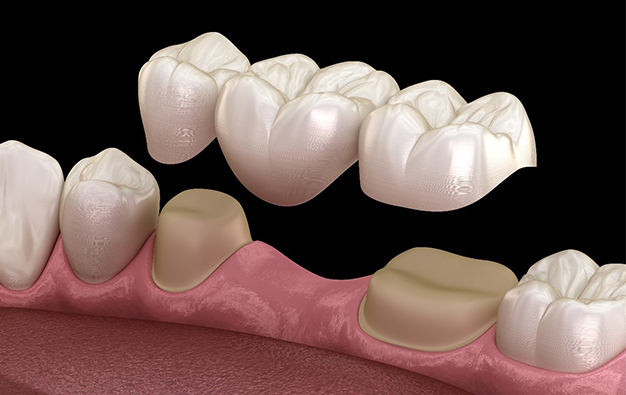Bridges
Minneapolis, MN

The process of replacing a missing tooth with a bridge begins by creating abutments out of your existing teeth where the bridge will be attached. The existing teeth are recontoured to provide a base for the bridge. Once the abutment teeth have been reshaped, we will use our intraoral digital scanner to electronically produce a 3D model of your teeth so that the bridge can be made to fit in the spot created for it, and match the surrounding teeth. Depending on the site and the desired material, the bridge will then either be made in-office and delivered to you same day, or the scans may need to be sent out to the dental laboratory. The bridge consists of two crowns on either end to place on the abutments and a pontic, which is the new tooth that replaces your missing tooth. If it needs to be sent to the lab, we will fit you with a temporary bridge while we wait for the permanent bridge to come back from the lab. This will protect the abutments and the exposed gum areas and look more appealing than having a missing tooth.
Once the permanent bridge has been created, we will try it in to make sure it fits perfectly and then it will be cemented onto the abutment teeth permanently. The bridge may take a little while to get used to, but after a few days it should feel like you have your own teeth back again. You should eat soft foods for the first few days after having your bridge placed. After the initial healing phase, you will be able to eat whatever you want with no issues.
If you are missing a tooth you should strongly consider having it replaced. Besides the aesthetic disadvantage of missing a tooth, it could also cause structural changes to your mouth and jaw, as well as making it difficult to eat or speak properly. Set up an appointment today to restore your smile
To begin the procedure, we will administer a local anesthetic to numb a specific area of your mouth, ensuring your comfort throughout. Following this, we will shape and file down the surrounding teeth to create enough space for the new fixed bridge. Impressions will be taken during this step to create both a temporary and permanent bridge.
Once the shaping and filing are complete, you will leave with the temporary bridge in place. However, a second appointment will be necessary to install the permanent bridge. During this appointment, the temporary bridge will be removed and the permanent one will be securely placed using a dental-grade adhesive. We will also polish the bridge and make any necessary adjustments to ensure a perfect fit.
Additionally, we will provide you with detailed instructions on how to properly brush and floss around the bridge. This will help maintain its longevity and ensure good oral hygiene.